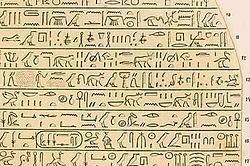 | ||
Reign c.338 – c.335 BCE (31st Dynasty) Successor Artaxerxes IV or Darius III | ||
Khabash, also Khababash or Khabbash, resided at Sais in the fifth nome of Lower Egypt in the fourth century BCE. During the second Persian occupation of Egypt (343–332 BCE) he led a revolt against the Persian rule in concert with his eldest son, from ca. 338 to 335 BCE, a few years before the conquest of Egypt by Alexander the Great. It is said that Nectanebo II, the exiled last native ruler of Egypt, may have helped in these events, but was possibly sidelined for good as a result of the failure of the revolt.
Little is known about Khabash. He is referred to as "Lord of both lands", i.e. King of Upper and Lower Egypt, and as "Son of Ra", another pharaonic title, and given the throne name of Senen-setep-en-Ptah in a decree by Ptolemy Lagides, who became King Ptolemy I Soter in 305 BCE.
Sometime in the 330s BCE, an Egyptian ruler called Kambasuten – who is widely recognized as Khabash – led an invasion into the kingdom of Kush which was defeated by king Nastasen as recorded in a stela now in the Berlin museum. An Apis bull sarcophagus bearing his name was found at Saqqara and dated to his regnal Year 2.
